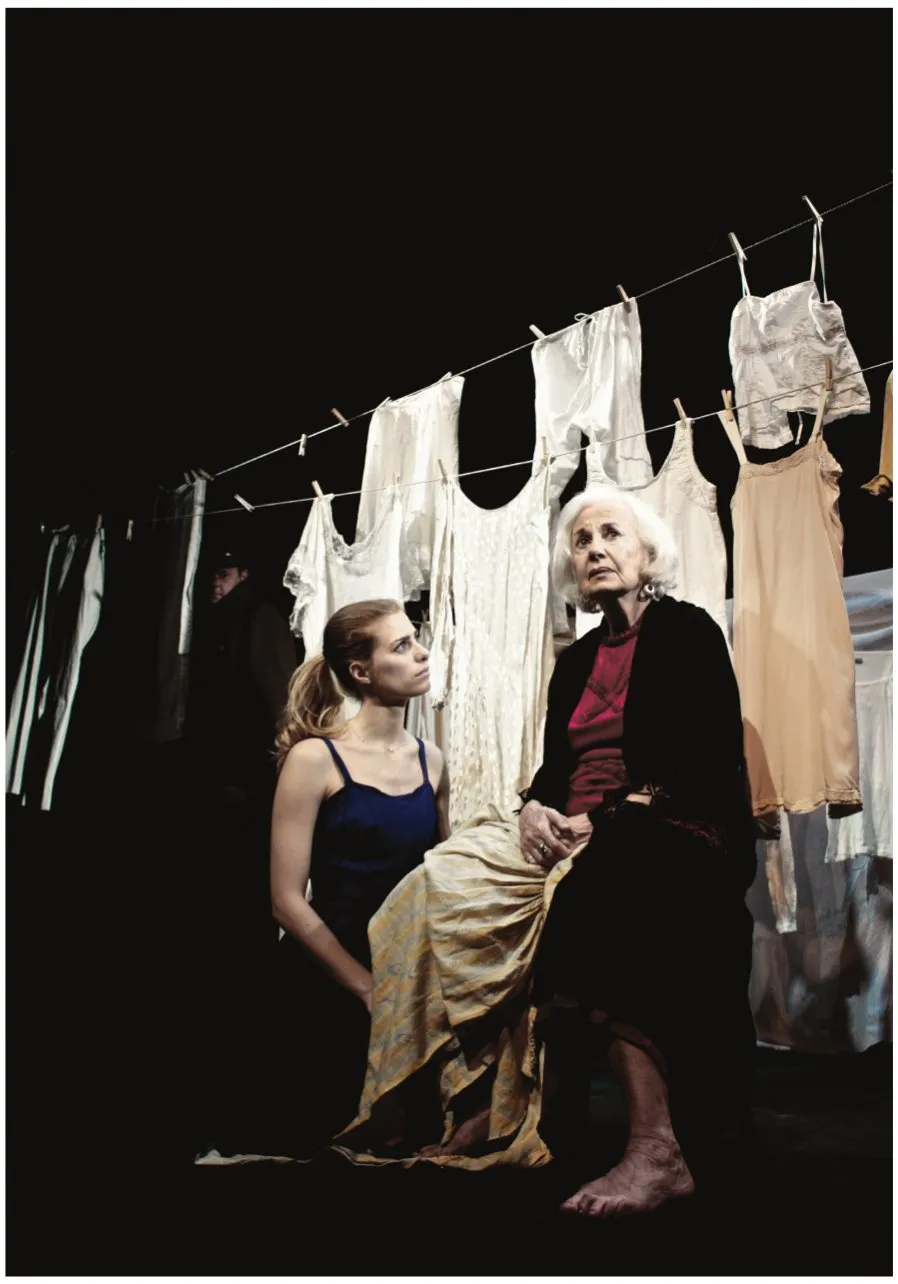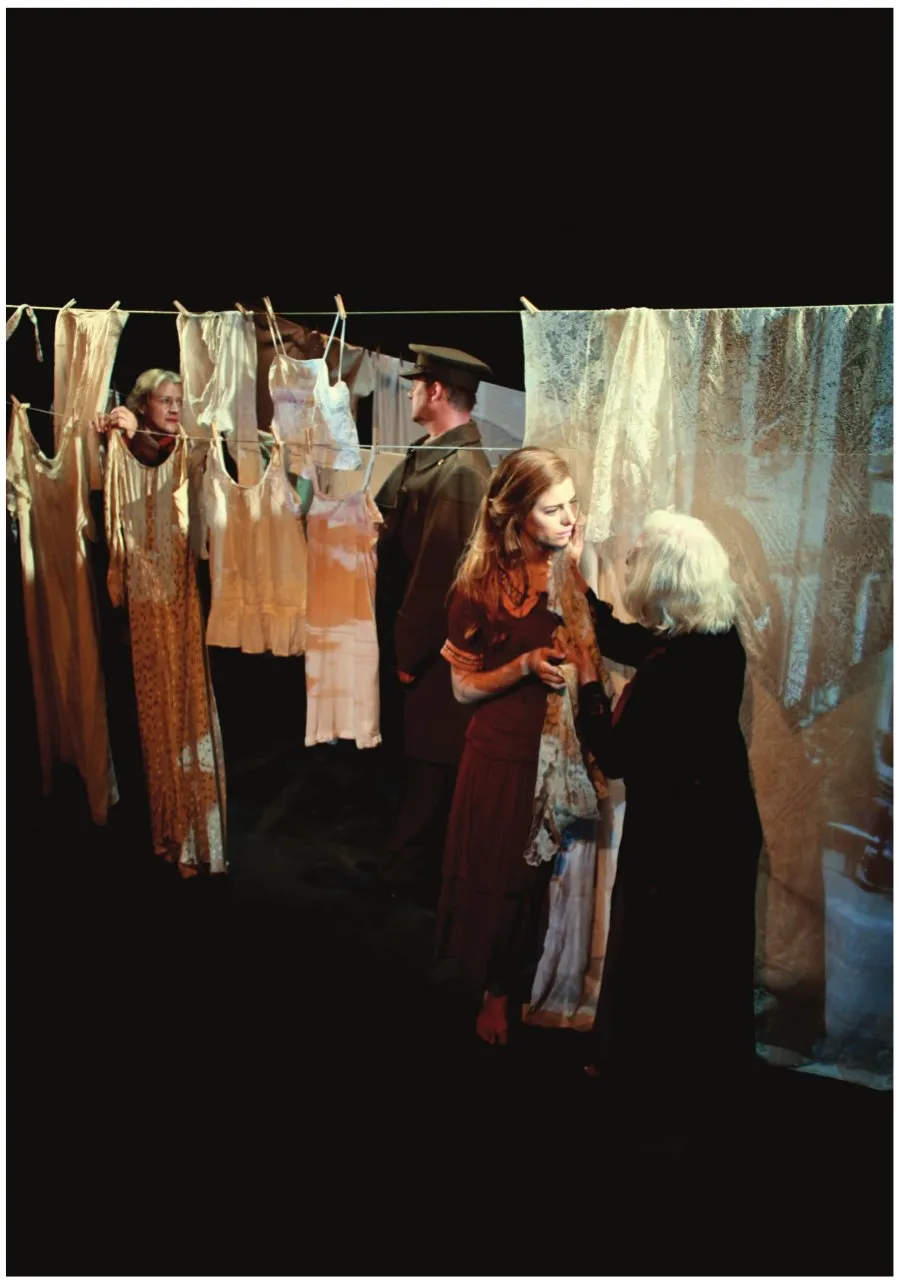1 The World of Devised
and Physical Theatre
Doing the Splits in Tight Trousers
There’s a difficult meeting point when performers, who perhaps are somersaulting six metres above the stage, want to play everyday people. They need to play recognizable characters and tell real stories while performing dangerous feats which no ordinary human could manage in skin-tight lycra, let alone in a suit and tie which might flap and catch, come untucked and rip.
How can a dancer perform an arabesque in a Victorian skirt that appears to weigh several kilos? How can you do a back flip in a hooded jacket without the hood falling over your face and blinding you for the all-important landing? What happens to the librarian’s specs when she is flying on the end of a rope, or walking on her hands in her dream of a more exciting life? What happens to the fairy’s wings in the rain?
These, and hundreds of other problems, present themselves during the design and making process of any production that calls for unusual movement or circumstance. Many of them are not apparent before rehearsals start because most of this sort of work is created through the devising process in the rehearsal room. But it is a great help to be prepared, and to invent designs that are sympathetic to the physical needs of the performer.
It is easy to forget, in the busy and engrossing work of making theatre, how much work the audience does in interpreting what they see and hear. They can be made up of theatrically experienced people and those who have never been to a performance before. We may put our ideas on the stage for them to see, but they interpret them each in their own particular way using their own particular experience and interest. Our ideas, which seem so solid and important to us as we turn them into words and music, sights and sounds, are only suggestions, and we have to trust the audience to enlarge them into reality.
The Setting and the Light
The setting in which the performers play their parts is the first thing that the audience sees, and helps their understanding of, and involvement in, the show. It gives people confidence that their interpretation is on the right lines, or tells them if they can allow their mind to create a more abstract world. The set is the frame and the context for the costume designer’s work. Physical theatre tends to make the most of any available stage space for the movement of the actors. The setting has to allow for this, which can mean that there is not much room for the actual set, and the costume and objects or props have to work together with the lighting to do the set’s job. The performers and the lighting designer are the people who give it life.
Without light the world that the designer makes for the performers and the audience is lifeless. In a controlled theatre space, where the light of any mood and place can be created, the audience’s attention is focused directly on the action. In the open air in the daytime the designer has to design for God’s lighting, which is less reliable though often no less theatrical. The first consideration will be the quality of the natural light. This depends on the country, the time of day, and where the sun is in the sky at the time of the performance. In some parts of the world this is reliable – for example July in the South of France is usually flooded with light. Northern climates can be more problematic, however, and colour has to be clear enough to show up in a grey, soft light if nature does not choose to give you the light you hope for when you want it.
Collaborative Company Design
RESEARCH AND DEVELOPMENT
Rehearsals for a devised performance are not the same as those for a performance that is script led. It is quite usual for this rehearsal period to be a research and development (‘R & D’) time. This means that the end result of this particular period will be either a short, rudimentary performance, possibly to attract future funding, or a springboard to the discussions and development of the finished work. These sessions are invaluable to the designer. The cast may not be the final choice for the performance, and much of the content will be unformed and experimental. But the style the company will work in, the atmosphere they hope to create on stage, and the reality or otherwise of the world they are inventing, will be clear.
All theatre technicians love gaffer tape (duct tape) and cable ties.
There will have been meetings, and perhaps casting workshops, before this collaborative creative period. The company will have been chosen not only for their skill, but also for their inventive ability. It can take a long time to assemble a company, and often a nucleus of the group will have worked together before and will have a tried and tested working relationship; new members will have been chosen for their ability to fit in with the group and to add fresh skills to the process. Designers for each production are chosen for the same reasons; their differing skills and particular specializations must be appropriate to the style of work envisaged.
The design of all areas used in the production will grow together. The number of different designers employed on a show varies with the scale of the production and its budget. Designers and makers who work in this field tend to have an open ability to design anything that appears on a stage, and particular skill in one or two fields. The costume designer for a devised production may also be responsible for the design of the set, effects, props or objects. If puppets and masks are being used they will be in her design brief unless other people with these particular skills have been employed.
Skills tend to overlap. A physical theatre company devising a piece may include actors who are also musicians, dancers, acrobats or puppeteers. Performers are trained in a wide variety of skills and know that their best chance of success in the ever-changing world of theatre is to have a wide base of expertise to draw on. The company may use one person in a variety of ways. An actor may make puppets and show others how to animate them, or use a specialized skill in movement for mask work, stage fighting or tumbling. Designers working in this type of theatre need a similar variety of chameleon skills.
COLLABORATION
A devising company will make decisions collaboratively. The designer’s vision encompasses the whole production as the audience will see it. Performers often have a picture in their head of the way they will look as a character, but their situation prevents them from imagining the production as a whole, or how they will look within it. It is important, therefore, that you all work together quickly and openly near the beginning of the rehearsal period, before actors’ visions become too fixed and engrained into their character development and movement, or yours into a characterization that does not exist.
In every department, through each stage of making a production, there runs a difficulty. So much is invented by so many different people, all of whom have been employed because of the skill, the speed and the variety of their invention, but not all of their improvisations and ideas can make it to the final production. Many will be followed and will perhaps have taken a long time to develop, and it can be hard for everyone to recognize, at the end...








